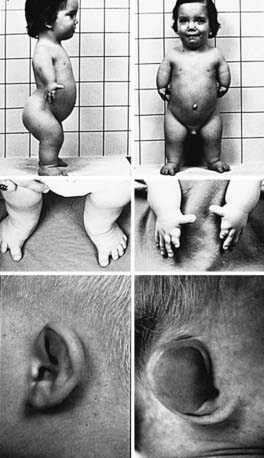Chapter 688 Disorders Involving Ion Transporters
Diastrophic Dysplasia
Diastrophic dysplasia (OMIM 22600) is a well-characterized disorder recognized at birth by the presence of very short extremities, clubfoot, and short hands, with proximal displacement of the thumb producing a hitchhiker appearance (Fig. 688-1). The hands are usually deviated in an ulnar direction. Bony fusion of the metacarpophalangeal joints (symphalangism) is common, as is restricted movement of many joints, including hips, knees, and elbows. The external ears often become inflamed soon after birth. The inflammation resolves spontaneously but leaves the ears fibrotic and contracted (cauliflower ear deformity). Many newborns have a cleft palate.




